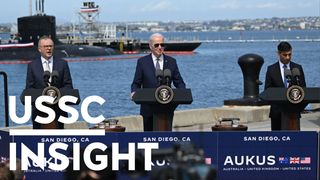The USSC's Director of Economic Security, Hayley Channer, discusses the AUKUS announcement, and why the cost of the new submarines sparked surprise in some circles.
Hayley, thanks for joining us. The submarine program costings sparked surprise in some circles. Why do you think this is?
Many people didn’t anticipate the extent to which AUKUS would dwarf previous cost estimates for a new submarine fleet. In 2016 we were told to expect over A$50 billion for a new fleet, and as recently as 2021 projections topped out at A$171 billion. At between A$268 – $368 billion, AUKUS stands to be the largest defence procurement in Australia’s history and involves a significant increase to defence spending as a percentage of GDP (from 2.05 – 2.20 per cent).
However, the headline price is spread over thirty years and no other national expenses are expressed over a similar time frame – all of them would look completely out of proportion. Moreover, the A$268 – $368 billion cost is comprehensive. It includes purchasing between three and five US Virginia-class submarines, designing and building eight new AUKUS-class submarines, upgrading naval infrastructure, investments in submarine production lines, workforce education and training, and sustainment. The original figures weren’t as comprehensive.
In your view, what is the big challenge in convincing the public that this cost is worth it, or do you believe the money can be better spent?
The biggest challenge facing the government is better communicating to the public the reasons Australia needs to grow the Australian Defence Force (ADF) and defence capabilities overall, not just AUKUS. This is a very sensitive task because, on the one hand, the Australian Government must articulate why countries like China pose a security challenge to Australia while at the same time not reinforcing negative trends in our relationship with China. This is partly the reason the case for AUKUS and nuclear-powered submarines hasn’t been made clearly or as often as it should have been in public discourse.
On AUKUS specifically and whether the money could be better spent, instead of judging it against other national priorities, it should be seen within the scope of defence spending overall. In that context, the Australia-UK co-design of a new ‘AUKUS class’ submarine and domestic build of eight boats will be the most expensive component, costing more than A$100 billion of the A$238 - $368 billion. Instead of this phase, Australia could purchase UK Astute-class submarines “off-the-shelf” and invest the savings into AUKUS’ other endeavour, which is to develop advanced defence capabilities. Developing hypersonic, quantum, AI, autonomy, and cyber capabilities could deliver additional benefit to Australia’s security within the same price tag.
From an economic security standpoint, is it wise for a nation to invest so much into a single capability?
There are always opportunity costs and trade-offs involved in any investment, especially for a project as costly as this. Whether 1/14 of the total Defence budget should go towards one capability or be spread more evenly within the Royal Australian Navy or between the three services, space and cyber domains, is a force structure question. The public-version of Defence Strategic Review, due for release in April 2023, should shed more light on the government’s thinking regarding force structure.
It’s also important to remember that AUKUS represents more than just a single capability. AUKUS is seeking to transform Australia’s entire defence industry and better integrate Australia’s defence industry with its US and UK counterparts. Although Australia’s government and society would like to avoid spending more on Defence, because we are in a more contested region, we need to face the reality of spending more on our national defence going forward. This will ultimately mean more economic strain and opportunity costs across our national resources.






